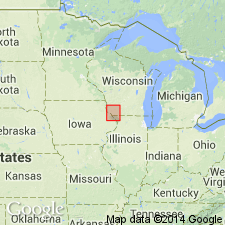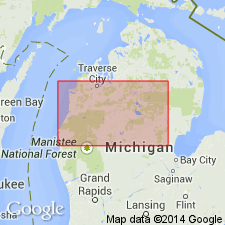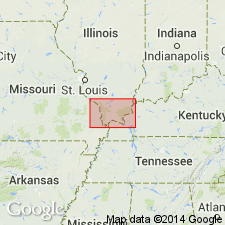
- Usage in publication:
-
- Prairie du Chien formation
- Modifications:
-
- Named
- Dominant lithology:
-
- Dolomite
- Sandstone
- AAPG geologic province:
-
- Wisconsin arch
Summary:
Prairie du Chien is proposed here as geographic name to replace "Lower Magnesian" of early reports. Includes (descending) Shakopee or Willow River dolomite, approximately 40 feet thick; New Richmond sandstone, 15 to 130 feet thick; and Oneota dolomite, 200 to 225 feet thick. Rests on Cambrian and is unconformably overlain by St. Peter sandstone. Age is Early Ordovician.
Source: GNU records (USGS DDS-6; Reston GNULEX).

- Usage in publication:
-
- Prairie du Chien group*
- Modifications:
-
- Overview
- AAPG geologic province:
-
- Wisconsin arch
Summary:
For many years the Prairie du Chien has been treated as a group and the Shakopee, New Richmond, and Oneota as formations. The Shakopee and New Richmond were for a time classified by the USGS as Lower Ordovician (Beekmantown) and Oneota dolomite (formerly classified as Lower Ordovician) was classified as Cambrian or Ordovician, it being assigned by E.O. Ulrich to his Ozarkian system. A.C. Trowbridge and G.I. Atwater (GSA Bull., v. 45, p. 78-79, 1934) would include all of Prairie du Chien group in Lower Ordovician, and it is so classified in the Report of the 9th Annual Field Conference of the Kansas Geological Society (1935) and by the USGS.
See also under Oneota dolomite, New Richmond limestone, and Shakopee dolomite.
Source: US geologic names lexicon (USGS Bull. 896, p. 1726).

- Usage in publication:
-
- Prairie du Chien Group
- Modifications:
-
- Revised
- AAPG geologic province:
-
- Michigan basin
Summary:
Nomenclature used in this report assigns Foster Formation to the Prairie du Chien Group. Foster includes the "Brazos shale" at the top and underlies the St. Peter Sandstone. Foster overlies Umlor Formation, also of Prairie du Chien. Foster is Early and Middle Ordovician and therefore its assignment modifies the age of the Prairie du Chien. [A 1987 abstract by C.T. Wheeler in AAPG Bull, v. 71, no. 9, p. 1112, also assigned Umlor and Foster Formations to the Prairie du Chien, along with overlying Bruggers and Goodwell Formations.]
Source: GNU records (USGS DDS-6; Reston GNULEX).

- Usage in publication:
-
- Prairie du Chien Group
- Modifications:
-
- Revised
- Areal extent
- AAPG geologic province:
-
- Illinois basin
Summary:
Knox Megagroup, as defined by Swann and Willman (1961), is replaced by Knox Group in southern part of Illinois basin. Although Droste and Patton (1985) recognized that the term "megagroup" violated the North American Stratigraphic Code (1983) and changed the term to Knox Supergroup in Indiana, the only group recognized within the supergroup is the Prairie du Chien, the type area of which is in WI. Prairie du Chien and its constituent formations have been described in northern IN and IL, but they are not traceable into Paducah quad. No control wells in southwestern IN were available to Droste and Patton (1985). In IL, Willman and others (1975) stated that the base of the Prairie du Chien could not be picked with confidence south of a line between Edgar and Monroe Cos., IL, north of Paducah quad. Even if boundaries of Prairie du Chien Group could be traced into southern IL, usage of the name is inadvisable as groups are customarily named to distinguish assemblages of similar formations from adjacent units of contrasting lithology. Prairie du Chien Group in WI is a logical group there because it comprises carbonate formations between top of Jordan Sandstone and base of St. Peter Sandstone. Jordan grades southward into dolomite of Eminence Formation in northern IL; thus Prairie du Chien loses its identity and merely becomes upper part of thick succession of carbonate rocks properly combined as the Knox. Knox is thus reclassified as Knox Group, replacing Knox Megagroup or Knox Supergroup. Prairie du Chien Group should be restricted to areas where Jordan Sandstone or equivalent clastic units are present.
Source: GNU records (USGS DDS-6; Reston GNULEX).
For more information, please contact Nancy Stamm, Geologic Names Committee Secretary.
Asterisk (*) indicates published by U.S. Geological Survey authors.
"No current usage" (†) implies that a name has been abandoned or has fallen into disuse. Former usage and, if known, replacement name given in parentheses ( ).
Slash (/) indicates name conflicts with nomenclatural guidelines (CSN, 1933; ACSN, 1961, 1970; NACSN, 1983, 2005, 2021). May be explained within brackets ([ ]).

